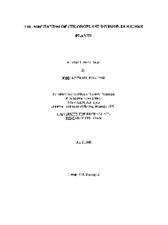| dc.creator | Proctor, John Michael | |
| dc.date.accessioned | 2013-02-22T20:42:02Z | |
| dc.date.available | 2013-02-22T20:42:02Z | |
| dc.date.created | 2000 | |
| dc.date.issued | 2013-02-22 | |
| dc.identifier.uri | https://hdl.handle.net/1969.1/ETD-TAMU-2000-Fellows-Thesis-P71 | |
| dc.description | Due to the character of the original source materials and the nature of batch digitization, quality control issues may be present in this document. Please report any quality issues you encounter to digital@library.tamu.edu, referencing the URI of the item. | en |
| dc.description | Includes bibliographical references (leaves 20-22). | en |
| dc.description.abstract | The majority of plant cells contain plastids that are self-replicating, double membrane organelles with their own unique genetic component. The current investigation concerns the developmental events that strictly determine the number of chloroplasts found in a normal mesophyll cell. The process of chloroplast biogenesis has been well characterized at the cellular level, but the molecular basis of chloroplast division and the role of nuclear genes in the control of plastid division and maturation are poorly understood. In young developing leaf cells proplastids number approximately 10 per cell. As the leaf continues to develop these proplastids divide and develop concomitantly until roughly 65 to 100 chloroplasts are present in each mature mesophyll cell. A gene controlling chloroplast division has been identified in Arabidopsis thaliana, and its inactivation results in a large decrease in the number of chloroplasts per cell. Because of the complexity of leaf development in Arabidopsis and other dicots, chloroplast division studies are typically very difficult. Unlike Arabidopsis, understanding the chloroplast division process in a grass species, such as rice, is greatly facilitated by the direct spatial and temporal relationship between chloroplast biogenesis and leaf development. To extend the body of knowledge of chloroplast division into the grass species, the Arabidopsis gene was used to isolate the corresponding gene in rice, Oryza sativa. To verify the function of this rice gene, it was introduced into the Arabidopsis mutant, characterized by a decreased number of chloroplasts, in order to reinstate chloroplast biogenesis in the mutant. A plasmid construct containing an antisense version of the gene and the hygromycin gene (used as a selectable marker) was then introduced into rice callus in order to knock-out production of the protein involved in chloroplast division. A phenotypic analysis of the resultant rice plants revealed that there was no significant reduction in chloroplast number. To determine gene expression patterns, mRNA was isolated from mature rice tissue and analyzed via the northern blot method. A Southern analysis of genomic DNA was performed to quantitate the number of integration sites of the antisense gene. | en |
| dc.format.medium | electronic | en |
| dc.format.mimetype | application/pdf | |
| dc.language.iso | en_US | |
| dc.publisher | Texas A&M University | |
| dc.rights | This thesis was part of a retrospective digitization project authorized by the Texas A&M University Libraries in 2008. Copyright remains vested with the author(s). It is the user's responsibility to secure permission from the copyright holder(s) for re-use of the work beyond the provision of Fair Use. | en |
| dc.subject | cell biology II. | en |
| dc.subject | Major cell biology II. | en |
| dc.title | The mechanism of chloroplast division in higher plants | en |
| thesis.degree.department | cell biology II | en |
| thesis.degree.discipline | cell biology II | en |
| thesis.degree.name | Fellows Thesis | en |
| thesis.degree.level | Undergraduate | en |
| dc.type.genre | thesis | en |
| dc.type.material | text | en |
| dc.format.digitalOrigin | reformatted digital | en |


